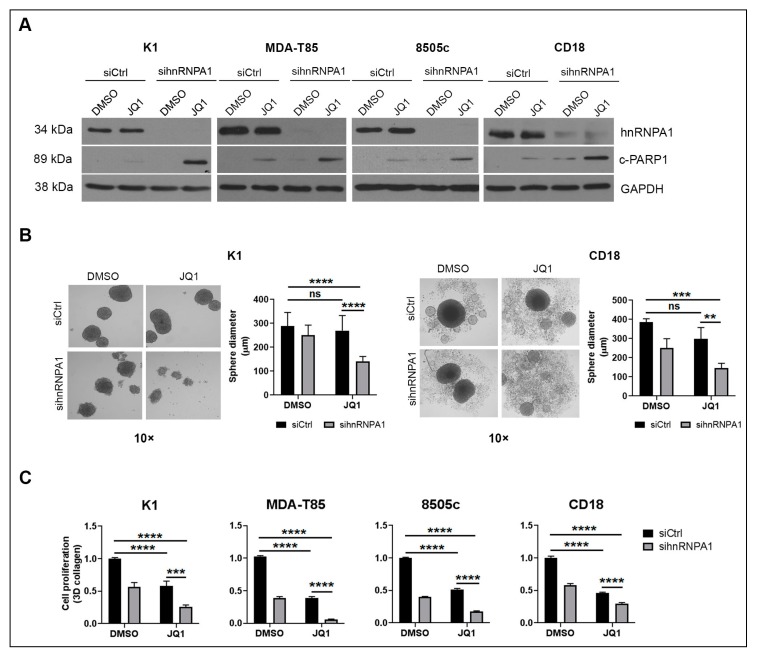Figure 2.
hnRNPA1 knockdown enhances the anti-tumor effects of BET inhibitors in cancer cells. (A) Cancer cells were transfected with siCtrl or sihnRNPA1 for 48 h, and then treated with JQ1 (1 µmol/L) for additional 24 h. Expression of hnRNPA1, c-PARP1 and GAPDH (loading control) were evaluated by western blot analysis. (B) Thyroid K1 and pancreatic CD18 cancer cells were transfected with siCtrl or sihnRNPA1 for 48 h, collected and grown in suspension cultures in the presence of DMSO or JQ1 (1 µmol/L) for additional 72 h. The ability of cancer cells to form tumor spheres was examined by phase microscopy. The results are representative of at least three independent experiments. Error bars represent SD from at least three technical replicates. Two-way ANOVA analysis was performed. **, p < 0.01; ***, p < 0.001; ****, p < 0.0001; ns, non-significant. (C) Thyroid and pancreatic cancer cells were transfected with control siRNA (siCtrl) or hnRNPA1-targeting siRNA (sihnRNPA1) for 48 h. The cells were then embedded in 3D collagen, treated with JQ1 (1 µmol/L) for additional 48 h, and the effect on cell proliferation was determined using the WST-1 assay. Two-way ANOVA analysis was performed. ***, p < 0.001 ****, p < 0.0001. Error bars represent SD from three technical replicates. Results are representative of at least three independent experiments. hnRNPA1: heterogeneous nuclear ribonucleoprotein A1; DMSO: dimethyl sulfoxide; JQ1: BET inhibitor; c-PARP1: cleaved PARP1; GAPDH: Glyceraldehyde 3-phosphate dehydrogenase (loading control); K1, MDA-T85: human papillary thyroid cancer cell lines; 8505c: human anaplastic thyroid cancer cell line; CD18: human pancreatic cancer cell line; SD: standard deviation; WST-1: tetrazolium salt converted by cellular mitochondrial dehydrogenases to formazan.

